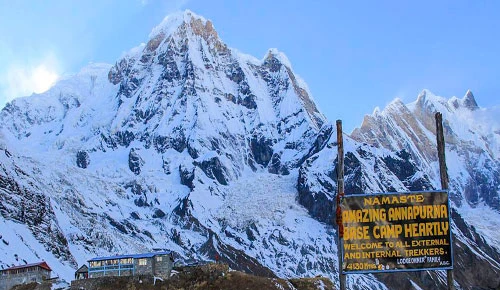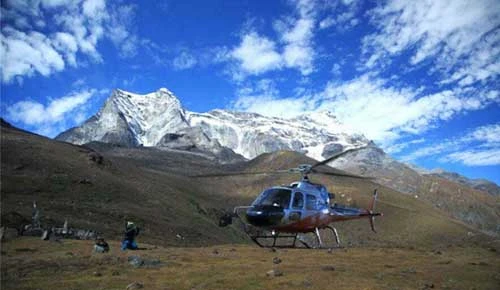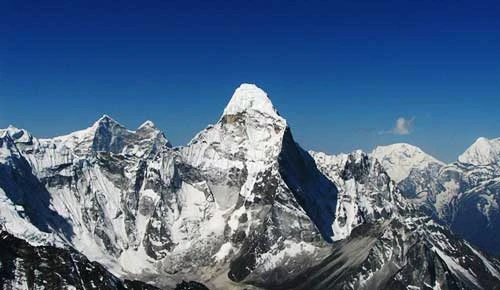Food During Everest Base Camp Treks
The Everest base camp trek is an amazing journey to the base camp of Mount Everest that offers a breathtaking view of the Himalayas as well as the delicious traditional food of Nepal. The food you eat along the way is just as interesting and gives you a look into the rich cultures of Nepal and the Sherpa people.
The food that you eat during your journey to Himalays isn't just something to eat but it's a way to connect with the land, the people who live there, and their traditions.
Nepali food, which is known for being simple but full of taste, is a big part of the trekking diet. The common lentil soup with rice, called Dal Bhat, is more than just a meal. It's a sign of kindness and plenty. After a long day of hiking, momos, which are steamed dumplings filled with meat or veggies, are a nice treat.
In the cold mountain air, thukpa, a hearty noodle soup, makes you feel better. When eaten in tea houses along the trail, these dishes feed both the body and the spirit, keeping trekkers going on their difficult trip.
There are cozy lodges called "tea houses" along the trekking route. At these houses, you can eat delicious local food and experience the friendly kindness of the Sherpa people. A hearty stew full of veggies and sometimes meat makes Sherpa Stew a healthy and filling meal.
Tibetan bread is a simple pancake that goes well with a hot cup of tea and a view of the mountains. Yak cheese is a specialty of the area and gives many dishes a unique taste. This shows how varied the food is in the Himalayas.
Table of Contents
Authentic Nepalese food
Nepal has a lot of different cultures and landscapes, and its food history shows this. As you move along the trails of the trek to Everest Base Camp, you will come across a wide range of tasty traditional Nepali dishes that provide food and a taste of the area's flavors.
Dal Bhat: The Staple Dish
In Nepal, Dal Bhat is more than just a meal. It's a way of life. It has steamed rice (bhat) and lentil soup (dal), as well as different veggie curries, pickles, and sometimes meat or fish. This food is good for you and has the right amount of carbohydrates, proteins, and important nutrients. It's a great choice for trekking in the Himalayas, which has some very rough terrain. Dal Bhat is a favorite among both locals and tourists because it is easy to make and can be used in many ways.

Momos: Nepali Dumplings
No trip through Nepal's food scene would be complete without trying Momos, the country's famous dumplings. You can either steam or fry these tasty dough balls filled with ground meat or veggies until they are just right. Momos are often served with hot dipping sauces that are made from tomatoes, chilies, and other spices. These sauces give the already tasty momos an extra kick. Momos are a must-try treat that perfectly captures the spirit of Nepali street food culture. They can be eaten as a quick snack or a hearty meal.

Thukpa: Noodle Soup
Originating from the Tibetan region, thukpa has become a popular comfort food across Nepal, especially in the mountainous regions. This hearty noodle soup is made with a savory broth, vegetables, meat (usually chicken or mutton), and hand-pulled noodles. Packed with warmth and flavor, Thukpa provides trekkers with much-needed sustenance and comfort, particularly on cold days or high-altitude nights. Its rich aroma and satisfying taste make it a favorite among locals and trekkers seeking a wholesome meal that warms both the body and soul.

Gundruk: Fermented Green Vegetables
Gundruk is a traditional soured vegetable dish that has a special place in Nepali food. Usually made from fresh greens like spinach, radish, or mustard greens, Gundruk goes through fermentation, which makes it taste better and gives it more nutrients. Along the Everest Base Camp Trek, trekkers may find Gundruk as a side dish or mixed into soups and stews. It adds a unique flavor and crunch to meals, and its probiotic qualities help with digestion, making it a popular choice among locals who want to keep their guts healthy.

Tea House Delicacies
The teshouse during Everest Trekking trial in the middle of the himalayas not only offer accommodation but also a taste of the unique food the the region. Here are some delicious foods that travelers must enjoy at tea houses along the way:
Sherpa Stew: Hearty and Nourishing
As hikers go higher into the mountains, they need food and clothing more than anything else. Sherpa stew is a hearty and healthy meal that makes you feel good inside and out. Sherpa stew is a comforting mix of flavors and textures. It is made with a rich broth, tender chunks of meat (usually yak or chicken), potatoes, and a wide range of local veggies. This healthy meal is full of nutrients that are important for high-altitude trekking. It gives you energy and keeps your body ready for the hard trip ahead.

Tibetan Bread: A Simple and Satisfying Snack
"Khapse," which is Tibetan for bread, is a simple but filling snack that you can find at tea houses along the trek. Tibetan bread is usually fried or cooked until it turns golden. It is made from simple things like flour, water, salt, and sometimes butter or yak milk. The dense texture and mild taste make it go well with hot drinks and make it easy for tired hikers to get something to eat quickly. Every bite of Tibetan bread is a treat, whether it's eaten by itself or with a drop of local honey or jam.

Yak Cheese: Unique Flavor of the Region
Yak cheese, which comes from the milk of the strong Himalayan yak, is very important in the food of that area. Along the trek, this unique treat can be tried at tea houses. It is usually given with Tibetan bread or mixed into other dishes. Yak cheese has a strong flavor and a unique sourness that make you think of the rough land it comes from. It gives trekkers a tasty and healthy snack that keeps them going on their trip through the Himalayas because it is high in protein and important nutrients.

Tsampa Porridge: Nutritious Breakfast Option
Tsampa is a traditional Tibetan food made from roasted barley flour that is known for being healthy and giving people energy. For trekkers getting ready for another day of adventure, Tsampa porridge is a healthy and filling meal that can be made with hot water or milk and sweetened with honey or sugar. Its earthy taste and creamy texture make it a comforting way to start the day, getting trekkers ready for the difficulties that lie ahead.

Hydration and Refreshments
During the difficult EBC Trek, drinking water and snacks are very important for keeping your energy up and staying refreshed. Trekkers come across different drinks along the way that not only satisfy their thirst but also help them feel better and re-energized as they deal with the difficult terrain and high altitude. Here are three choices that stand out:
Butter Tea: Traditional Himalayan Beverage
Butter tea, which is also called "suja" or "po cha," is an important part of Himalayan culture, and the Sherpa people drink it all the time. Strong black tea, salt, and yak butter are mixed in this unique drink to make a rich, smooth drink that keeps you warm and fed in the cold mountain weather. Adding butter makes it a great choice for trekking tired people after a long day on the road because it gives them energy when they need it. Even though it has a strange taste, butter tea quickly becomes a favorite comfort drink for many people starting the Everest Base Camp Trekking.

Lemon Tea: Refreshing and Rejuvenating
Even though the Himalayas are rough and high, a simple but refreshing drink like lemon tea can do wonders for waking up tired bodies and lifting emotions. When you steep fresh lemon juice and tea leaves in hot water to make lemon tea, you get a burst of citrus flavor and a small caffeine boost to fight fatigue. Because it's light and energizing, it's a great choice for staying hydrated during breaks on the trail or as a morning pick-me-up before starting the day's hike. Trekkers often feel better when they drink lemon tea after a long day of exploring the beautiful Everest area.

Hot Cocoa: Comfort in a Mug
A hot mug of cocoa is one of the most comforting things to have after a hard day of hiking through rough terrain and changing weather. Hot cocoa, which is made with rich cocoa powder, milk, and a touch of sweetness, brings comfort, warmth, and a sense of home in the middle of the Himalayas' remote wildness. Trekkers can take a break and rest by the fireplace or in the warmth of a tea house while sipping a cup of velvety hot cocoa. This gives them time to recharge before continuing their journey. During the Everest Base Camp Trek, hot cocoa is sure to make you feel warm and happy, whether you drink it as a treat at the end of a long day or as a way to relax before bed.

Through these options for staying hydrated and refreshed, trekkers can stay energized, hydrated, and at ease as they start the adventure of a lifetime through the stunning landscapes of the Everest area.
Conclusion
As we finish our food tour of the Everest Base Camp Trek, it's clear that the experience is more than just beautiful scenery and tough physical challenges. During our trip, we've explored the wide range of Nepali food, tried hearty Sherpa food, and enjoyed the warmth of traditional Himalayan drinks. From the warm warmth of Dal Bhat to the strange tastes of yak cheese, each dish has made our trip more interesting.
Enjoying the different kinds of food along the trail not only fills the body but also makes the soul happy. It shows how strong and creative the people in these areas are that they were able to make these delicious foods in some of the harshest settings in the world. We have a better understanding of the culture and habits of those who live in the shadow of Everest because we have tasted these foods.
Either you are doing the Everest Helicopter Tour, the EBC Short Trek or the Long Everest Trek, don’t miss the opportunities to taste the different authentic Nepalese foods of the Everest Region.








